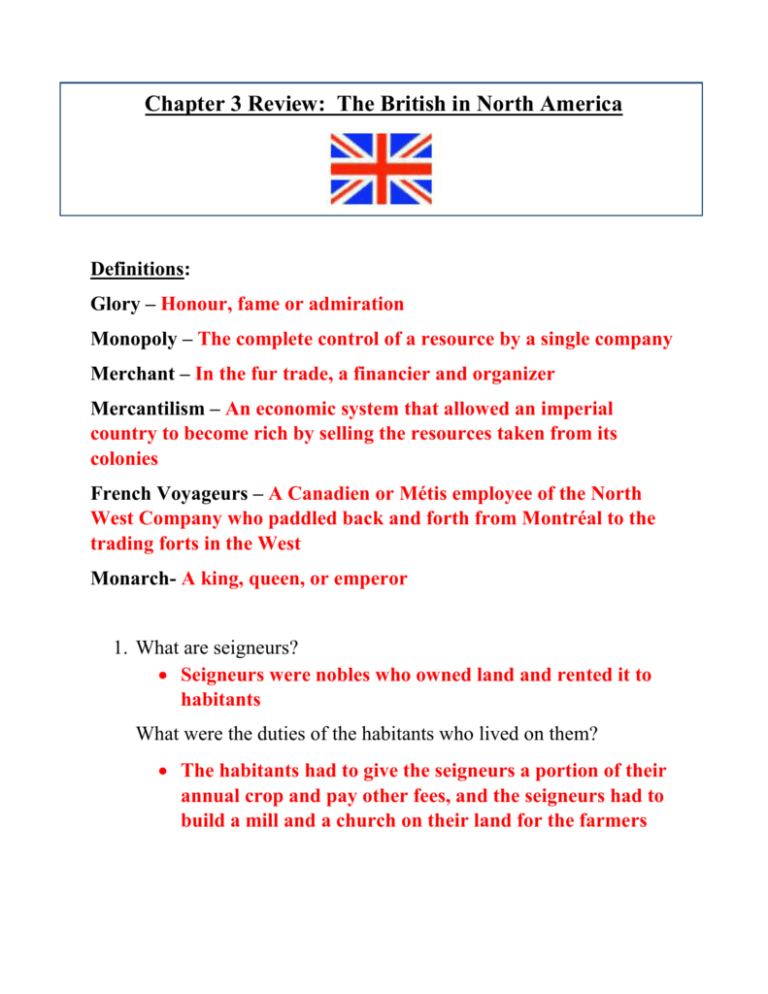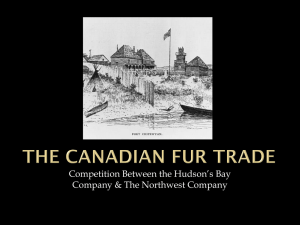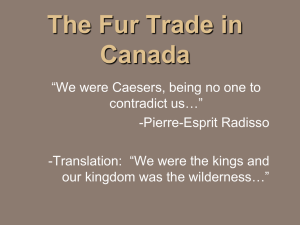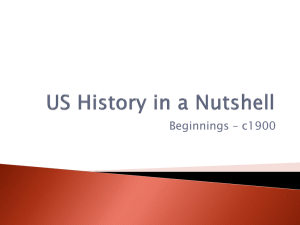Chapter 3-4 Review KEY
advertisement

Chapter 3 Review: The British in North America Definitions: Glory – Honour, fame or admiration Monopoly – The complete control of a resource by a single company Merchant – In the fur trade, a financier and organizer Mercantilism – An economic system that allowed an imperial country to become rich by selling the resources taken from its colonies French Voyageurs – A Canadien or Métis employee of the North West Company who paddled back and forth from Montréal to the trading forts in the West Monarch- A king, queen, or emperor 1. What are seigneurs? Seigneurs were nobles who owned land and rented it to habitants What were the duties of the habitants who lived on them? The habitants had to give the seigneurs a portion of their annual crop and pay other fees, and the seigneurs had to build a mill and a church on their land for the farmers Fill in the Blank 2. The Sovereign Council was established to rule New France. It included a governor, The Bishop of Quebec and a (n) Intendant. 3. To keep their land grants seigneurs had to recruit habitants to farm it. 4. Mercantilism is a(n) economic system that allowed a(n) home country to become rich off of resources taken from its colonies. 5. Why did the Thirteen Colonies grow faster than New France? Warmer weather Better farmland More opportunity (farming, fishing, and logging) Britain invested money in its colony, but France did not All faiths were allowed to settle there New France France was not interested in spending heavily on its North American colonies. The climate of the St. Lawrence Valley and Acadia was extreme. The early economy of New France was based mainly on the fur trade. Only French Catholics were encouraged to come to New France. The Thirteen Colonies Britain invested a lot of money in its colonies overseas. The climate was mild especially in the southern colonies. The economies of the British colonies were based mainly on farming, fishing, and logging. There were more opportunities to earn a living. The Thirteen Colonies allowed settlers from many faiths to settle there. 6. Using the above information, list the similarities. • Both had colonies overseas 7. Using the above information, list the differences. • France did not spend money on its colony; Britain did • New France = extreme climate Thirteen Colonies = mild climate • Economy New France = fur trade Thirteen Colonies = farming, fishing, and logging • New France = French Catholics Thirteen Colonies = many faiths 8. In 1670 what company was granted a monopoly by King Charles II? Hudson’s Bay Company What area of land did the monopoly cover? Any land whose water flowed into the Hudson’s Bay What did they call it? Rupert’s Land, after Prince Rupert Chapter 4 Review: Competition for Trade Definitions: St. Lawrence River- Because this river connects the Great Lakes and the Atlantic Ocean, it served as the main route for European exploration of the North American interior. It was also important for the transportation of furs. Metis – People of mixed First Nations and European ancestry who identify themselves as Métis people. They are distinct from First Nations, Inuit and non-Aboriginal peoples. The Métis history and culture draws on diverse ancestral origins such as Scottish, Irish, French, Ojibway and Cree. Hudson`s Bay Company – This company began as a fur trading company and is the oldest commercial corporation in North America and one of the oldest in the world. North West Company - The North West Company was a fur trading business headquartered in Montreal from 1779 to 1821. It competed with increasing success against the Hudson's Bay Company in what was to become Western Canada. With great wealth at stake, tensions between the companies increased to the point where several minor armed skirmishes broke out, and the two companies were forced to merge. Middlemen – The HBC used middlemen between its forts along Hudson Bay and First Nations to the west. 1. Which geographic routes did the French and British use to establish their quest for furs? British (HBC) used the rivers from the Hudson Bay French (NWC) controlled trade along the St. Lawrence River and the Great Lakes. They used water routes because they were fast and convenient. 2. Who had the best relationship with the First Nations? …the French or the British? French 3. Explain the reasons for your answer. The French (NWC) went TO the First Nations to trade, so they needed a good relationship. The British (HBC) expected the First Nations to come to the HBC trading posts. Fill in the Blank 4. Economic competition helped develop the fur trade. 5. The early fur trade led to expansion inland toward the west. 6. As the fur trade developed, it became less beneficial to the First Nations. 7. Québec and Montréal were two main French fur trading and shipping centres in the 1600s. 8. The loss of the Ouendat as middlemen between the French and First Nations, resulted in the coureurs de bois trading directly with First nations. New France France was not interested in spending heavily on its North American colonies. The climate of the St. Lawrence Valley and Acadia was extreme. The early economy of New France was based mainly on the fur trade. Only French Catholics were encouraged to come to New France. The King of France controlled French interests in the fur trade. Coureurs de bois lived in New France, and spent their money in their settlements. To avoid conflict with First Nations, French settlers were not allowed to build forts in the interior of North America. France wanted resources such as furs. French colonists saw First Nations as partners. France viewed non-Christian people as inferior. How did the French treat First Nation peoples? Convert them to Catholicism. The Thirteen Colonies Britain invested a lot of money in its colonies overseas. The climate was mild especially in the southern colonies. The economies of the British colonies were based mainly on farming, fishing, and logging. There were more opportunities to earn a living. The Thirteen Colonies allowed settlers from many faiths to settle there. The King of England gave control of the fur trade to a privately owned company…HBC HBC just wanted to make a profit. Britain built forts along the Hudson Bay so that ships could easily reach the forts. Britain wanted land for farms. British colonists saw First Nations as obstacles. Britain viewed First Nation people as inferior. How did the British treat First Nation peoples? Pushed them aside. 9. Using the above information, list the differences. • all of the above are differences • • 10. How was Britain`s interest in the fur trade different from New France? France wanted resources such as furs. Britain wanted land for farms. 11. What was the name of the company that competed with the Hudson’s Bay Company? North West Company What happened involving these two companies? When the fur trade slowed down, both companies were struggling so they merged under the name of the Hudson’s Bay Company. 12. List the ways First Nations provided aid to the Europeans during the fur trade. Showing them how to find food Teaching them how to make medicine to cure diseases such as scurvy Providing advice on how to dress for the cold weather Providing transportation in the form of canoes, snowshoes, and toboggans Sharing their knowledge of the region Translating trade deals with various groups Helping them negotiate Providing a workforce to cook food, sew moccasins, prepare pemmican, snare animals, lace snowshoes, and so on








